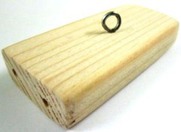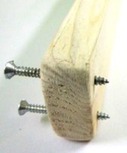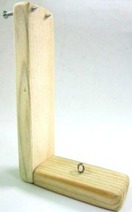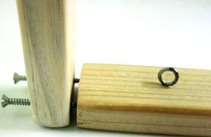The Levitating Astronaut activity uses the amazing power of magnets to help children to learn about magnetism and leads on to a brief introduction of gravity.
Levitating Astronaut
 Brief Description
Brief Description Materials
Materials- Neodymium magnet
- Paper clip
- 4x 3 mm screw
- Large piece of wood
- 2x small piece of wood
- Cup hook
- Thread
- 2x astronaut image

 Learning Objectives
Learning Objectives- Introduce the concept of magnetism in a fun and engaging manner
- introduce children to the basic concept of gravity
- use invisible magnetic fields to teach children the importance of questioning
- observing and investigation.
 Background Information
Background InformationMagnetism
Magnets are solid objects which have the ability to attract materials such as iron, cobalt and nickel, along with various other alloys.
All objects are composed of atoms, which are made up of several different particles, including negatively charged electrons that rotate around the atom nucleus. In magnetic objects the electrons are, at least largely, spinning in the same direction around the nucleus – this is what causes the object to become magnetic.
In each magnetic object there are many different groups of atoms, each group forms its own mini-magnet called a domain. Magnetic domains that are pointing in opposite directions cancel one another out. The more domains that are allignedaligned (facing the same direction), the stronger the overall magnetic field. In magnets all, or at least most, domains are facing the same direction, combining to create one large magnetic field.
All magnets have a North and South pole, this is due to the alignment of their domains. Opposite poles attract and the same poles will repel.
Magnets can be natural or induced. Magnets that create their own magnetic fields all the time are called Permanent or hard magnets. Temporary or soft magnets only create a magnetic field for a short time, after being in the presence of another magnetic field.
The strongest natural magnet is Lodestone. By repeatedly rubbing lodestone along a piece of iron in one direction the iron also becomes magnetised (this is how compasses were created). It is essentially the same process that is used to magnetise the neodymium that is used in this activity.
Gravity
Gravity is a force that attracts all objects to each other. This is why we don't fall off the Earth even though it is round. It may help to think of 'down' as towards the centre of the Earth. The more massive an object is, the stronger its gravitational pull. This is why, gravity on the Earth is stronger than on the moon and people feel lighter on the moon (6 times lighter!). This is also why astronauts that areout in space, far from any planets or stars, float.
 Full Activity Description
Full Activity DescriptionMagnetic levitation, maglev or magnetic suspension is a method by which an object is suspended with no support other than magnetic fields. Magnetic pressure is used to counteract the effects of gravity and any other accelerations.
Step 1
Fix a cup hook onto one small piece of wood

Step 2
Fix a neodymium magnet into the other small piece of wood

Step 3
Fix a screw into each corner of the large piece of wood

Step 4
Attach both small pieces of wood to the larger piece using the inserted screws to make a frame

Step 5
Tie the piece of thread to the paper clip

Step 6
Glue the paper clip (now with thread attached) to the back of an astronaut image, then glue on the other astronaut image so the paper clip is hidden between the two

Step 7
Attach the thread to the cup hook and adjust so that the astronaut does not reach the opposite end of the frame. (Cut away any extra thread)
Step 8
Watch your astronaut levitate!
 Additional Information
Additional InformationDanger for children
Do not let children under the age of 14 play with magnets and always supervise any child playing with these magnets. If several small magnets are swallowed, they can get stuck in the intestines and cause major swelling, life-threatening injuries and need surgery to remove them. If they place them onto a television screen or computer monitor screen, permanent damage can occur as colours will become permanently distorted.
Keep larger magnets out of children's reach, as you would sharp knives or other dangerous materials, as fingers can be crushed between the powerful magnets.
Crushing, blood blisters and cuts
When larger magnets are brought close enough together they can have a surprising amount of power. Fingers are quickly caught between them which can cause blood blisters or cuts. Wear gloves when handling larger magnets and use caution. Practice handling smaller magnets first. Do not place these magnets up your nose or around the ears as they have soft tissue that will compress as the magnets attract through the thickness of the tissue and as the magnets get closer as a result, they exert yet more force which crushes still further etc. etc.
Magnetically sensitive items
Neodymium magnets are very much stronger than 'ordinary' magnets. Keep a safe distance (200mm+) between the magnets and all objects that can be damaged by magnetism. These include mechanical watches, heart pacemakers, CRT monitors and televisions, credit cards, diskettes and other magnetically stored media such as video tapes.',



 Keywords
Keywords Connection to National Curriculum
Connection to National Curriculum Source
Source License
License Attachments
Attachments Downloads
Downloads


